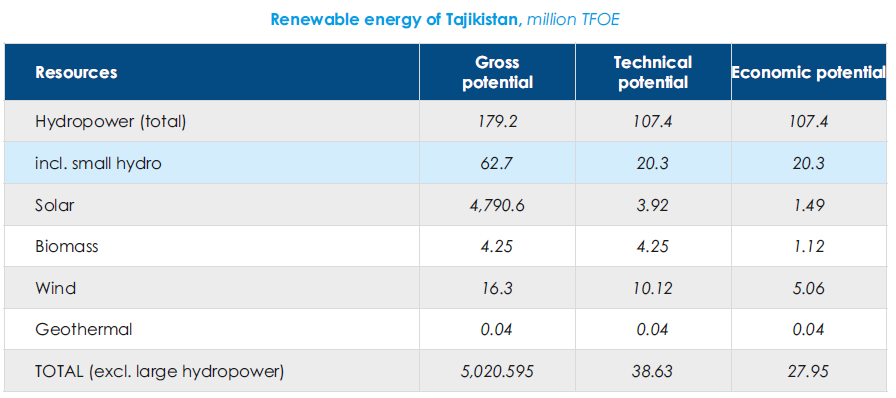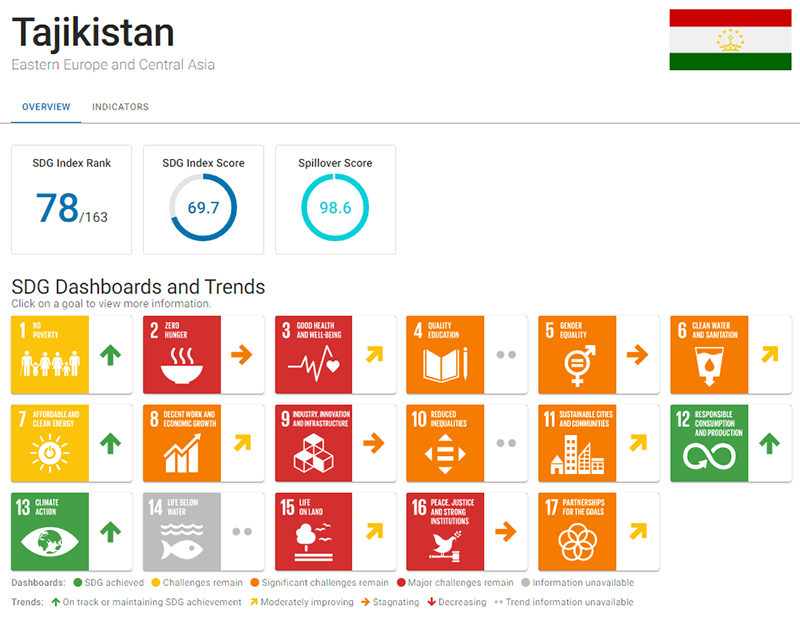
Section 5. Key water developments in the countries of Central Asia
5.3. Republic of Tajikistan

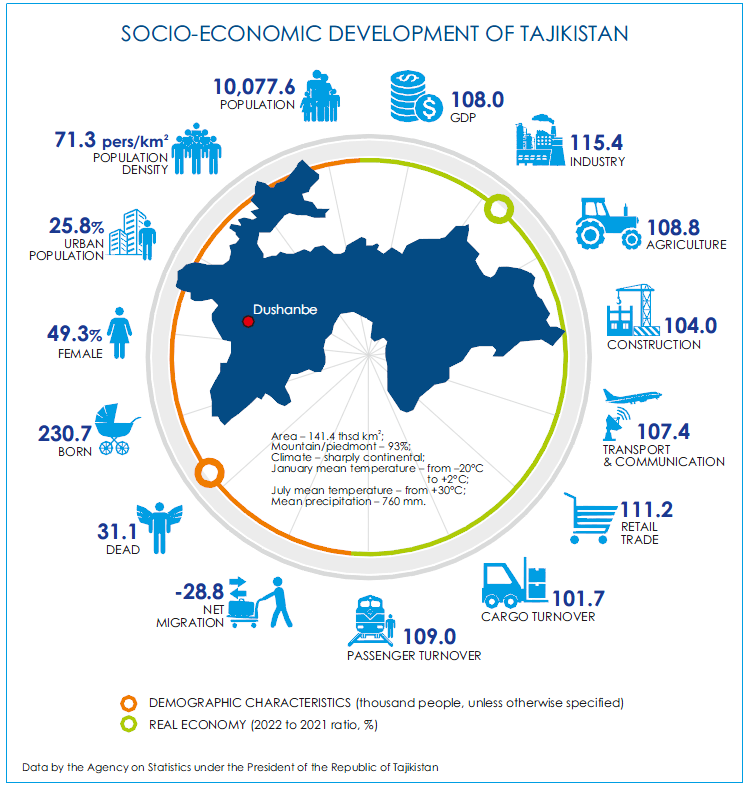
Water Sector
Water resources. Tajikistan has got water resources from glaciers, rivers, lakes, reservoirs and groundwater. There are 14,509 glaciers with the total glaciation area of 11,146 km2 (approx. 8% of the country’s area) and the total glacial volume of about 845 km3. 947 rivers stretching to more than 28,500 km flow across the country. The average annual river runoff is 64 km3/year (including 80% of the Amu Darya River and 1% of the Syr Darya River) or 55.4% of the average long-term annual surface runoff in the Aral Sea Basin. Tajikistan possesses about 1,300 lakes covering 705 km2. The lakes contain over 46.3 km3 of water, including 20 km3 of freshwater. There are 11 operational reservoirs, with the total water surface area of 664 km2 and the total capacity of 15,344 km3, which is equivalent to 13% of the average long-term annual runoff in the Aral Sea Basin. The potential groundwater stock is 18.7 m3/year, while usable groundwater resources are estimated at 2.8 km3/year.
The main water consumers in Tajikistan are irrigated agriculture, which accounts for 85% of the total water use, household and drinking water supply - 5%, industry - 5%, fishery - 2%, and other sectors - 3%.
Latest developments in legislation. The “2022-2027 State Program on development of new irrigated land and reclamation of land withdrawn from agricultural production” and the Action Plan for its implementation were approved (PP RT No.90 of 01.03.2022).
New appointments. B.T.Zukhurzoda was appointed Deputy Director of the Agency for Land Reclamation and Irrigation under the Government of Tajikistan (UP No.171 of 11.04.2022); M.B.Rakhmatzoda - Head of the Center for implementation of the Irrigation of the Danghara Valley Project (UP No.170 of 11.04.2022).
2016-2025 Water Sector Reformation Program and projects. According to MEWR , since 2016, 2,693 million TJS have been used for the Program, including 597 million TJS in 2022. In 2022, (1) a new Water Code and amended laws “On drinking water and drinking water supply” and “On Water User Associations” , as well as 17 by-laws regulating the water sector were adopted; the National Water Strategy of the Republic of Tajikistan up to 2030, the basin plans for water resource management in the Syr Darya, Zerafshan, Panj, Kafirnigan, Isfara and Isfana River basins, and the Programs for rehabilitation of industrial water supply systems and their equipment with water meters were developed; the large-scale work was undertaken to assess conditions of the water supply and sanitation sector for development of the 2030 State Program for water supply and sanitation; (2) basin zones and 5 basin organizations under the MEWR were identified; 5 basin councils for the Syr Darya, Zeravshan, Panj, Vakhsh, and Kafirnigan River basins were established; the work was initiated for the improvement of management structure in the water supply and sanitation sector.водоотведения.
The “Procedure and method for drafting water balances” was approved (Resolution of MEWR No.45 of 01.12.2022). The “State program on water supply and sanitation until 2030” and the “Concept for the support of water education in Tajikistan by 2030” were developed.
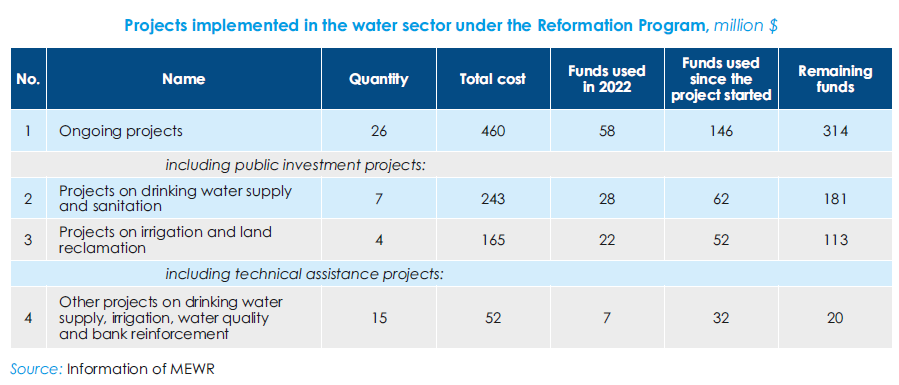
Source: Information of MEWR
In the land reclamation and irrigation (+bank reinforcement) sphere, 4 projects are currently underway. The total cost is $165 million of which about 80% is allocated for infrastructure rehabilitation and construction. In 2022, $22 million were used.
The following projects were continued: (1) “National water resource management in Tajikistan”/NWRM (SDC, CHF 6.4 million, 2018-2023); (2) “Water resource management in the Panj River basin” (ADB) to increase agricultural production and food security through improved water resources management; (3) “USAID regional water and vulnerable environment activity” (2020-2025) aimed at strengthening water cooperation among the CA countries to enhance stability, economic prosperity and sustainable ecosystems.
To support MEWR in the Reformation Program, the project “Integrated rural development (IRD)/“Towards rural inclusive growth and economic resilience (TRIGGER)” (BMZ, EU, and GIZ, 2019-2024) concluded a cooperation agreement with UNDP . The partnership will focus on: (1) improvement of knowledge coordination and management in the water sector among all stakeholders; (2) awareness raising on the reform process and building of ownership; (3) engagement of personnel from MEWR in global reform developments; (4) improvement and development of the legal framework of the reform; (5) promotion of IWRM and gender, planning, and risk management; (6) integration of policies related to water, climate, energy, food and biodiversity through a nexus system.
The Government of Tajikistan and ADB signed a $30-million grant agreement to modernize the Yavan irrigation and drainage system in the lower basin of the Vakhsh River. The lower house of the Parliament ratified the agreement (April). The project will improve agricultural and water use productivity and empower women in land and water management.
The WB Board of Executive Directors approved the IDA grant of $30 million for the project “Tajikistan strengthening water and irrigation management” aimed at (i) strengthening capacity for water resource planning and irrigation management in Tajikistan and (ii) improving performance of selected irrigation schemes in the Vakhsh and Zerafshan River basins.
For UNDP projects, see “United Nations and its Specialized Agencies”.
Events. The fowling events were organized: (1) 2nd International High-level Conference on the International Decade for Action “Water for Sustainable Development”, 2018-2028 (June 6-9, Dushanbe, Tajikistan), see “2022 Calendar of Events”; (2) First Geneva Water Dialogue and workshop on water and disaster risk reduction with participation of the Permanent Mission of Tajikistan to the UN (July 1, Switzerland); (3) 9th meeting of the National Commission on Irrigation and Drainage of the Republic of Tajikistan (December 8, Dushanbe).
The delegation of MEWR took part in the: 9th World Water Forum and meetings on the margins of the Forum (March 21-26, Dakar, Republic of Senegal); (2) 4th Asia-Pacific Water Summit (April 13-24, Kumamoto, Japan); (3) 2022 Petersburg International Economic Forum (June 16, Saint Petersburg); (4) High-level Symposium on Water and 3 roundtables “Synergies between SDG6 and SDG14 – an integrated vision of the whole hydrological cycle: strengthening cross-sectoral approaches to accelerate implementation of related targets, including financing and governance”, “Water and Sanitation Services bridging SDG6 and SDG14” and “Existing successful and innovative partnerships to support the implementation of SDG6 and 14: challenges, opportunities and actions” under the UN Ocean Conference (June 27, Lisbon, Portugal); (5) World Water Week “Seeing the unseen: the value of water” (August 28, Stockholm, Sweden).
Drinking Water Supply
Projects. In the water supply and sanitation sector, 7 projects worth of $243 million are underway. $28 million were used in 2022. This resulted in commissioning of: (1) new drinking water supply networks in Khujand city (project by “Sadaf” SUE, 2 million TJS), Gazantarak village in Sogd province (with the support of the Tajik Government), villages of Kabadiyan, Shakhri and Farkhor districts (“Tajikistan prosperity” project, 2018-2023, USAID, Aga Khan Foundation); (2) 1,000-m3 tank for water supply in Buston city (tripartite between the SUE “Housing and Communal Services of RT”, EBRD and the “Rehabilitation of water supply systems in northern cities of Tajikistan” project).
The loan agreement was ratified between the Republic of Tajikistan and EBRD on the “Fayzabad Water and wastewater” project (Resolution of MNMO RT No.789 of 29.06.2022).
Agreements were signed (1) with EU to start allocating €29 million in grants, of which €14 million is earmarked for rural drinking water supply; (2) with EBRD for more than €8 million to restore key water supply and sewerage infrastructure in Kulyab city - more than 100,000 residents will have access to improved water supply and sanitation services, and water losses will be reduced to 35%. Grants were approved: (1) by the WB Board of Executive Directors for $45 million to finance the “Water supply and sanitation” investment project in Khatlon province; (2) by ADB for additional financing of $38 million to improve water supply and sewerage systems in Dushanbe city. It is expected that 125,000 people will get 24/7 piped water supply, and 500,000 people will benefit from improved sewerage.
EBRD and SECO will provide €4.4 million for modernization of water supply networks in Fayzabad district, Rasht Valley.
Agriculture
Agricultural production. In 2022, the total agricultural output accounted for 49.2 billion TJS, which is 8% more than in 2021. Production of grain amounted to 1.6 million tons, potatoes – 1 million tons, and vegetables and fruits – 3.2 million tons.
Agricultural export. In 2022, Tajikistan exported 191.2 thousand tons of agricultural commodities (17.6 thousand tons less than in 2021) to 20 countries (92% - CIS countries, 8% - other countries) for $54.3 million ($17.6 million more than a year earlier). In particular, the country exported 76.6 thousand tons of vegetables, 54.5 thousand tons of fruits, and 52.4 thousand tons of dried fruits.
Gross Domestic Product (GDP) amounted to 115.7 billion TJS (over $11.3 billion), which is 8% more than in 2021. The inflation rate was 4.2%, which is 3.8% less than in the last year.
Latest developments in legislation. The “2022-2027 State Program for development of new irrigated land and reclamation of land withdrawn from agricultural production” was approved (PP RT No.90 of 01.03.2022). The law was adopted “On state support to agro-industry of the Republic of Tajikistan” (No.1866 of 18.03.2022); it determined the institutional, legal and economic framework of state support to agro-industry and envisages regulation and sustainable management of the latter.
The rates of land and single agricultural tax were approved for 2022-2026 in the cadastral zones of cities and districts of the republic, including mountainous zones (PP RT No.206 of 27.04.2022).
New appointments. (1) S.G.Karimzoda was appointed Minister of Agriculture (UP RT No.322 of 26.01.2022); (2) M.B. Mirzozoda – First Deputy Minister (PP RT No.5 of 26.01.2022); (3) Dj. Nosirzoda – Deputy Minister (PP RT No.285 of 10.06.2022).
Projects and international cooperation. As part of the “Towards rural inclusive growth and economic resilience”/TRIGGER Project, aimed, inter alia, at increasing the added value of agricultural production in Tajikistan, a series of trainings for trainers was held to develop knowledge and skills of project partners, rural advisors and agronomists to raise farmers' awareness of climate change and integration of adaptation measures, especially in the Zerafshan and Rasht River valleys (March-April). Support was provided to the Tajik delegation for a study tour to South Korea (November 13-20).
As part of the Feed the Future program, the “Tajikistan agriculture and land governance activity” addresses the root causes of poverty, hunger and malnutrition through agricultural development and increased sustainability of rural communities in 12 districts of Khatlon province (Balkhi, Dusti, Zhayhun, Zhami, Khurasan, Kushoniyon, Nosiri Khusrav, Kubadiyan, Levakand, Shakhritus, Vakhsh and Yavan).
The WB approved an additional grant of $50 million for the “Strengthening resilience of agriculture sector” project , which will support the procurement and distribution of seeds, fertilizers and compact machines to vulnerable farmers, including women farmers.
Memorandum of cooperation was signed between the Ministry of Agriculture and: (1) the Ministry of Agriculture of Egypt (March); (2) the Irkutsk State Agrarian University named after A.A. Ezhevsky, Russian Federation (March).
For UNDP projects, IFAD and FAO activities in Kyrgyzstan see “United Nations and its Specialized Agencies”.
Energy
Energy production and export. In 2022, the total electricity production in Tajikistan increased to 21.4 billion kWh, which is 775.7 million kWh (3.8%) more than in 2021. Electricity exports reached more than 2.5 billion kWh, which is 118.4 million kWh (5%) more than in 2021. In just eleven months, the country raised more than $103 million, which is 10.2% more than in the same period of 2021 (about $93.5 million).
Public administration reforms. The public entity “Mechanized Construction and Repair of Hydraulic Structures” was established at the Agency for Land Reclamation and Irrigation under the Government of Tajikistan (PP RT No.615 of 29.12.2022).
Latest developments in legislation: (1) electricity and heat tariffs were approved for different groups of consumers (PP RT No.449 of 31.08.2022) ; (2) state financial support was provided to the “Barki Tojik” OSHC by reducing the debt to the “Sangtuda-1 HPP” OJSC in the amount of 282.4 million TJS, which was formed due to purchase of electricity (PP RT No.605 of 20.12.2022).
New appointments. M.Sh.Asozoda was appointed Chairman of the “Barki Tojik” OSHC (PP RT No.12 of 27.01.2022), A.A.Kurbonzoda - Deputy Chairman (PP RT No.13 of 27.01.2022); S.A.Kholmukhamadzoda (PP RT No.286 of 10.06.2022) and M.B.Safarzoda (PP RT No.287 of 10.06.2022) were appointed Deputy Ministers of Energy and Water Resources; T. Gafurzoda – Head of the State Service on Supervision of Hydraulic Structure Safety (PP RT No.345 of 25.06.2022).
Projects and international cooperation. As part of the “Project Vanch I: improving quality of life through reliable power supply” (Royal Norwegian Ministry of Foreign Affairs (RNMFA) in cooperation with Aga Khan Foundation and Pamir Energy, 2020-2022), the construction of the remaining 25 km of 110-kV transmission line was completed in Vanch-Darvaz district; now it connects the regional electricity grid of GBAO to the national grid of Tajikistan.
The WB is currently financing 25 projects in Tajikistan for a total of $1.3 billion. An additional grant of $80 million was approved under an ongoing project on rehabilitation of electricity facilities.
EU also allocates €15 million to support the country's energy sector.
Alternative Energy
In Tajikistan, the hydropower potential is estimated at 527 billion kWh per year. However, existing capacities allow generating only 18 billion kWh of electricity per year (less than 5% of the potential). At the same time, the share of hydropower in the country's fuel and energy budget is more than 95%. About 300 small HPPs have been built in the country, and another 600 small HPPs can be built.
The gross potential of solar energy is estimated at 1,822,894 MW (4,790.6 million TFOE/year); the technical potential is 1,493.7 MW (3.92 million TFOE/year); the economically viable potential is 545.2 MW (1.49 million TFOE/year). Wind energy potential is 60,167 MW (163 TFOE/year). The efficiency of wind plants was 55% in July and 100% in January.
In his address to the Parliament at the end of 2021, the President of Tajikistan stated the need for wider use of solar and wind energy. Accordingly, by Presidential Decree No.432 of 19.08.2022 the draft Agreement between the RT and EU on financing the “Sustainable energy support program in Tajikistan” for €15 million was approved.
The delegation of Tajikistan presented information on the: (1) country's potential for generating environmentally clean energy and contribution to the reduction of harmful emissions by expanding energy ties with the countries in the region that use conventional energy duribf the ministerial panel session “Building a strong foundation for a resilient and sustainable energy and water services sector” (May 9, Abu Dhabi, UAE); (2) relevance of global transition to clean and sustainable energy at the “Uzbekistan 2022” Energy Forum and a number of working meetings during the event (June 23-24, Tashkent);(3) development of a solar power project and other alternative energy projects during the 60th meeting of the CIS Energy Council (July 14, Nur-Sultan).
Hydropower Construction and Modernization
Yavan HPP. Tajikistan and Uzbekistan started construction of a 140-MW hydropower plant on the Zerafshan River. The plant will generate 700-800 million kWh per year (July).
Rogun HPP. In 2022, 3.2 billion TJS were allocated from the state budget for construction work. The Ministry of Finance was instructed to replenish the authorized capital of the “Rogun HPP” OJSC at the expense of the Stabilization Fund for Economic Development by 200 million TJS (at about $20 million).
The excavation work is further continued to prepare main basins and access routes to them, flatten the site and reinforcing mountains to a level of 1,552 m. Tunneling, reinforcement of water delivery, concreting, construction and mounting work are underway in the site of the main dam. Efforts on the dam body, including in head- and tail-water parts and in the core of the dam are continued.
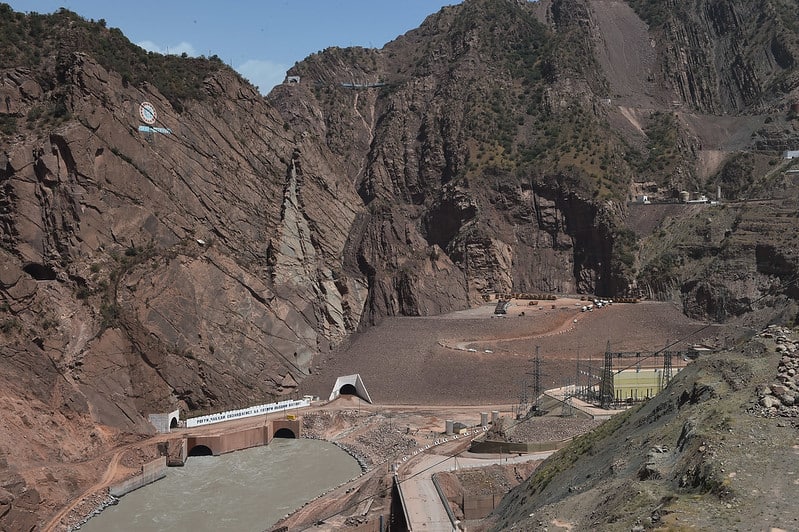
Source: Press service of the President of RT
Since the start of operation (November 2018, September 2019), two hydrounits generated more than 4.6 billion kWh of electricity.
Small Sebzor HPP. As part of bilateral cooperation between Germany and Tajikistan, an agreement was signed on additional financing of the construction for €17.4 million (May). Consequently, the total financing of the project will amount to €53 million. The HPP will generate up to 77.6 GWh of electricity per year and will improve access to sustainable, reliable and affordable electricity for the rural population in GBAO.
A contract was signed between the “TGEM” OJSC and Pamir Energy to construct 3 km of road, machine hall, and water intake, install 3 km of pipelines and deliver hydraulic equipment to the run-of-river plant (December).
Sarband HPP. The 49-MW 3rd unit was commissioned, reconstruction of 220- and 110-kV power substations was completed, and work is underway on reconstruction of hydrounit 1 (March). After the complete reconstruction, the capacity of the HPP will increase to 270 MW, and the service at the plant and power supply will be significantly improved.
Nurek HPP. In 2022, the first 375-MW unit was commissioned as part of the first phase of reconstruction. It is expected that the new unit will generate 1,380 GWh per year, which is 135 GWh more than by previous unit (October). An agreement was signed with the WB to finance ($65 million) the second phase of the “Nurek HPP rehabilitation” project; the allocated funds will be used, inter alia, for reconstruction of the remaining 6 units, overhaul of nodes of hydroturbine, etc. (May).
Kairakkum HPP. Reconstruction of the HPP is 80% complete – three units were replaced, work was completed on the precise design and production of turbines, generators, transformers, auxiliary system, water gates of main turbine, construction part of the project for units 5 and 6; research and preparatory work was finished.
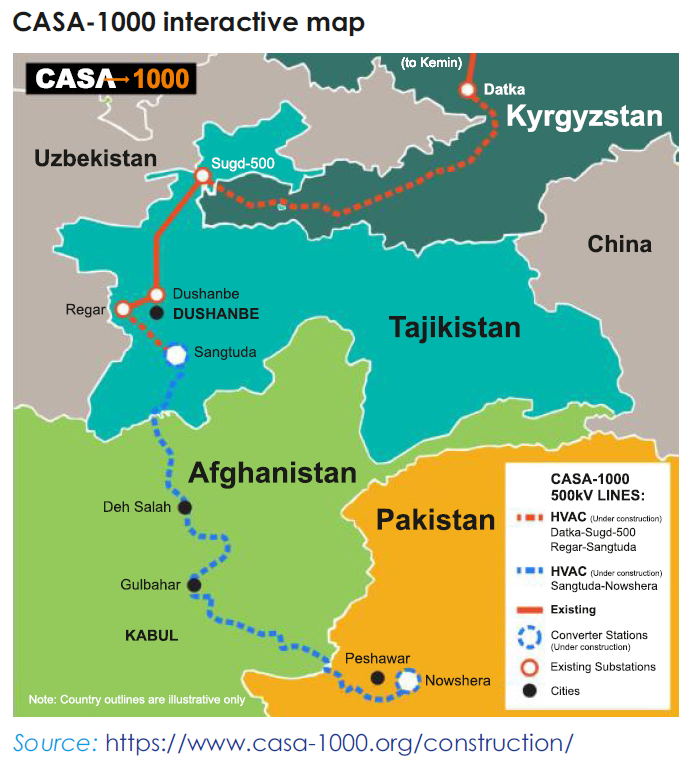
Construction at the Sangtuda converter substation is over 98% complete, while general construction is 90% complete. The installation of major electrical components is underway, and all seven main converter transformers were assembled. The following interventions are in progress: (1) construction work to upgrade two substation sites along the CASA-1000 route (Sughd-500 and Regar-500); (2) construction of transmission towers along the entire length of the CASA-1000 system in the country, while construction of the HVDC line from Sangtuda to the Afghan border is fully completed.
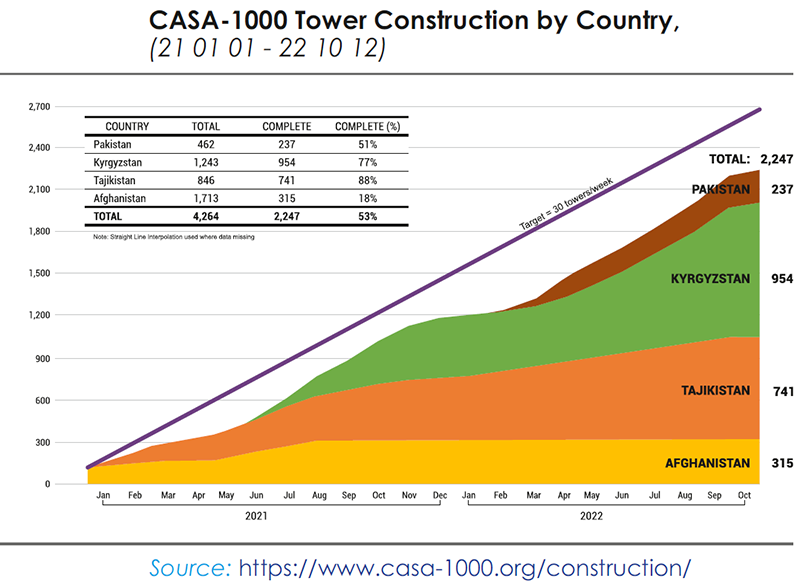
Climate Change, Glaciers and Environmental Protection
At the initiative of Tajikistan, the 53rd plenary meeting of the 77th UNGA session unanimously adopted the resolution “International Year of Glaciers’ Preservation, 2025” (December 14, New York, USA). The resolution: (1) “…declares 2025 the International Year of Glaciers’ Preservation and to proclaim 21 March of each year the World Day for Glaciers, to be observed starting in 2025”; (2) “…invites Governments, intergovernmental and non-governmental organizations, major groups, other relevant stakeholders and donors to voluntarily contribute to the trust fund in support of activities for glaciers’ preservation, to be coordinated by the Secretary-General, in partnership with relevant agencies of the United Nations system…”; (3) “…welcomes the generous offer of the Government of Tajikistan to convene an international conference dedicated to glaciers’ preservation in Tajikistan in 2025…”.
Latest developments in legislation. The “Strategy for green economy development in the Republic of Tajikistan for 2023-2037” was approved with the aim to develop green economy, adapt to climate change, reduce greenhouse gas emissions, efficiently use natural resources, and mobilize capital and energy-saving technologies (PP RT No.482 of 30.09.2022).
New appointments. N.I.Nazarzoda was appointed Deputy Director of the Forestry Agency under the Government of Tajikistan (UP RT No.172 of 11.04.2022).
Projects. The “Technology-based adaptation to climate change in rural Tajikistan and Kyrgyzstan” (2019-2022) project was completed: (1) the developed Geoportal provides access to up-to-date geographic information of Tajikistan and enables national partners and other stakeholders to explore and share it with each other; an Earth Observation Laboratory and unified metadata standards consistent with the system in place in Kyrgyzstan were established; (2) legal and regulatory framework was improved, and a working group was established to promote and develop the National Spatial Data Infrastructure initiative; (3) training was conducted in GIS, RS, digital data management, cloud analysis of climate data and satellite image processing, etc.; (4) a detailed site assessment was conducted, and local climate change adaptation plans were drafted for pilot districts of the project (Penjikent, Khovali, Muminabad, Vakhdat and Rudaki districts).
The eco-technological “ClimIT” (Switzerland) project was launched ; in the first phase, students will get technical skills in graphic design and will study modules on environment and waste management, while in the second phase, they will work together with experienced mentors to develop a package of communication materials and initiatives aimed at raising public awareness and reducing plastic use in Dushanbe. The following events were organized in Dushanbe: (1) kick-off seminar (June 3); (2) meeting with the Swiss Ambassador to Tajikistan (December 8); (3) courses on graphic design, digital marketing, and UX/UI design.
The information on other projects is available on
For UNDP projects, see “United Nations and its Specialized Agencies”.
International cooperation. As part of the official visit of the President of Tajikistan to Uzbekistan, 15 documents on bilateral cooperation were signed, including the Memorandum on cooperation on environmental protection and rational environment management between the Committee for Environmental Protection under the Government of Tajikistan and the State Committee for Ecology of Uzbekistan .
Events. As part of the Green Climate Action month (August 21-September 17), the following events were held: eco-podcast series “Listen Green”, training “Joint mapping in Tajikistan” (August 23, Dushanbe), roundtable “Potential for development of cross-border cooperation in protected natural areas between the Republic of Tajikistan and the Republic of Uzbekistan” (August 31, Dushanbe), “Clean environment is a guarantee of human health” campaign (September 3, Dushanbe).
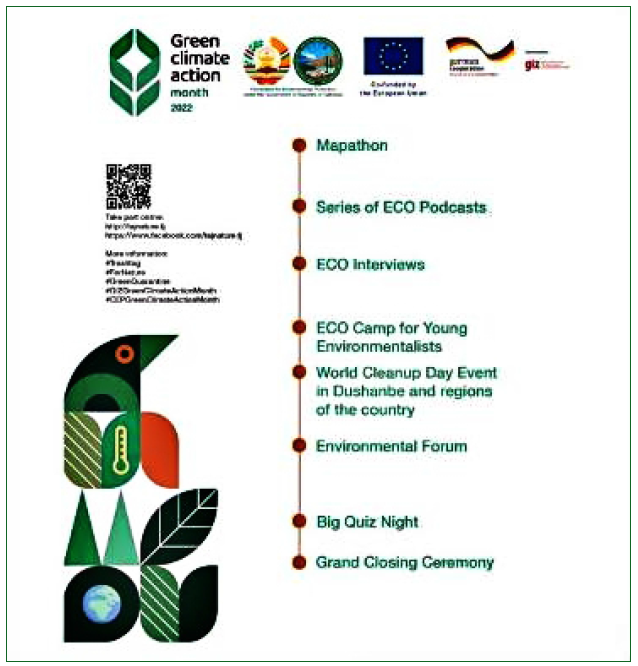
Source: Committee for Environmental Protection under the Government of Tajikistan
The following events were organized in Dushanbe: workshop on NDCs monitoring (July 26-29); national meeting and workshop on “Accelerating transition to circular economy in 2021-2024” (September 6-7); meeting of representatives of the Committee for Environmental Protection and UNECE on the results of the 3rd Environmental Performance Review and preparation of the 4th Review (November 22); roundtable on preparation of a new (third) edition of the Red Book of Tajikistan (November 29); roundtable “Outcomes of the 27th Conference of the Parties, UN Model Convention on Climate Change” (December 6); roundtable on implementation of the “Strategy for green economy development in the Republic of Tajikistan for 2023-2037” with broad participation of representatives of ministries, agencies and development partners (December 14); consultation meeting “Supporting the implementation of Tajikistan's NDCs” (December 21); roundtable “Glaciers of Tajikistan is the Ice Heart of Asia” at the branch of the Lomonosov Moscow State University (December 29).
As part of the “Comprehensive State Program for environmental education in the Republic of Tajikistan for 2021-2025” , the following events were organized: (1) mobile information tour in the tourist-resort complex “Temurmalik Island” (August, Sogd province); (2) lessons, talks and meetings on environmental topics (September 28, Dushanbe); (3) meeting with students of the Tajik Technical University named after academician M.S.Osimi (November, Khujand); (4) training for representatives of the education sector, teachers of ecological and life sciences (November, Kanibadam); (5) winter ecological camp (November 30-December 3, Gulistan); (6) interdepartmental conference on the Program (December 15, Dushanbe); (7) training “Clean environment for children and adolescents” (December 22, Dushanbe).
The delegation of Tajikistan took part in the (1) high-level thematic debate “Moment of Nature” (July 19, New York, USA); (2) 9th Environment for Europe Ministerial Conference (October 5-7, Nicosia, Cyprus); (3) UN Climate Conference/СОР 27 (November 7-18, Sharm el Sheikh, Egypt).
SDG in Tajikistan
Tajikistan and the UN signed the “Sustainable Development Cooperation Framework for 2023-2026” (7 June, Dushanbe).
Tajikistan was ranked 78 among 163 countries in the annual sustainable development rating.
Emergencies and Natural Disasters
Latest developments in legislation. The “Medium-term State Program for protection of population and territories from emergencies for 2023-2028” and 2023-2025 Action Plan for implementation of the Program were approved (PP RT No.630 of 29.12.2022). The key priorities of the Program include: (1) public awareness of DRR; (2) development of institutional and legal framework for this system; (3) attraction of investments from international organizations and the state budget to ensure earthquake-resistant construction; (4) training of the population and rescuers in responding to emergencies.
Natural disasters. In 2022, 697 emergencies were registered (359 in 2021), including 46 natural disasters (52 in 2021); the damage to the country's economy amounted to almost 53.3 million TJS. Heavy rains in RRS, GBAO, Sogd and Khatlon provinces resulted in mudflows that damaged houses, crops, livestock, and roadbeds were destroyed.
Preventive measures. Hydraulic facilities were enforced to ensure accident-free operation in case of emergencies on the territory of the Kayrakkum reservoir (Tajik Sea) in Sogd province; mudflow protection structures and a flood control dam were rehabilitated in Ayni makhalla of Shurob Isfara rural jamoat. In Khatlon province, engineering and technical measures were taken to prepare rivers for unimpeded passage of mudflows and to prevent flooding during heavy rainfall and intensive melting of glaciers; work was organized to prevent the harmful effects of mudflows, landslides and water rise in rivers.
Projects. Within the framework of the “National disaster risk management” project (ADB) aimed at supporting the efforts of the Government of Tajikistan to reduce economic losses due to natural disasters, the following events were held: (1) training course “Disaster risk reduction training to develop the curriculum strategy with the Ministry of Education of the Republic of Tajikistan” (February 2-5); (2) workshop on climate impacts and adaptation (November); (3) workshop on development of a monitoring and information system to implement the “National strategy for disaster risk reduction for 2019-2030” (November 29). ADB approved a $30-million grant complementing the ongoing project to strengthen disaster risk management in Tajikistan.
As part of the “Strengthening disaster resilience and accelerating implementation of Sendai Framework for Disaster Risk Reduction in Central Asia” project (EU), the following events were held: (1) two workshops on self-assessment (May 17-18, Dushanbe); (2) workshop on the use of DesInventar-Sendai disaster information management software (July 20-21, Dushanbe); (3) regional forum of emergency ministers of the Central Asia republics on disaster risk reduction: strengthening the resilience of the Central Asian region to disasters (October 4-6, Dushanbe); (4) children's drawing contest as part of the International Day for Disaster Reduction (October 13, Dushanbe); (5) project final meeting (February 15, 2023, Almaty, Kazakhstan).
The “Tajikistan preparedness and resilience to disasters” project is about to start (WB, IDA, $50 million, 2022-2027); it envisages investments in building the resilience of key infrastructure to natural hazards, improving climate risk mitigation and building national capacity for disaster risk management and climate change adaptation.
International cooperation. The delegation of Tajikistan took part in the 25th session of the General Assembly of the International Civil Defense Organization, where the Chairman of the Committee for Emergency Situations of Tajikistan signed: (1) a Memorandum of cooperation on emergency management and response with the National Emergency Crisis and Disasters Management Authority of the UAE Supreme Council for National Security; (2) Memorandum of understanding with the Disaster and Emergency Management Authority of Turkey (November 22-24, Abu Dhabi, UAE).
Events. The delegation of Tajikistan took part in the: (1) 7th Session of the Global Platform for Disaster Risk Reduction (May 23-28, Bali, Indonesia); (2) 34th meeting of the Interstate Council on Natural and Man-Caused Emergency Situations (November 25, online, Baku, Azerbaijan); (3) High-Level Central Asian dialogue “From global knowledge to local solutions: climate resilient institutions in Central Asia” (December 2, Tashkent, Uzbekistan).
Foreign Policy and International Cooperation
Working and official visits. In 2022, the President E.Rakhmon paid official and working visits to Egypt, Iran, Uzbekistan, Pakistan, China, Russia, Kazakhstan, Kyrgyzstan and Armenia, where the matters of bilateral cooperation and achieved results were discussed.
Development of alliances and strategic partnerships. E.Rakhmon paid an official visit to Uzbekistan in June, where: (1) 15 documents on bilateral cooperation were signed; (2) cooperation aspects, including water and energy use, were discussed; (3) a wide range of regional and international security issues, including problems in Afghanistan were considered, etc.; (4) a launching ceremony of the joint Tajikistan-Uzbekistan project on hydro construction in the Zerafshan River basin was held (June 2-3). See “Bilateral Water Cooperation between the Countries of Central Asia”.
The President of Tajikistan took part in the: (1) CSTO meetings (May 16, Moscow, Russian Federation and November 23, Yerevan, Armenia); (2) 4th Consultative Meeting of the Heads of CA States (July 21, Cholpon-Ata, Kyrgyzstan); (3) meeting of the Council of Heads of SCO States (September 16, Samarkand, Uzbekistan); (4) CIS informal meetings (October 7 and December 26, Saint Petersburg, Russia); (5) 6th CICA Summit (October 13, Astana, Kazakhstan); (6) 1st summit “Central Asia+Russia” (October 14, Astana, Kazakhstan); (7) 1st EU-Central Asian leaders' meeting (October 27, Astana, Kazakhstan).
Foreign investments. According to the results of 2022, the inflow of direct investments from other countries to the republic amounted to about $430 million, of which 85% were directed to mining, 13% - production and processing, 1.7% - construction and other spheres. 21 new agreements were signed with development partners to implement public investment projects totaling over $717 million. As of January 2023, 72 public investment projects worth $4 billion are implemented in the country.
Chairmanship in IFAS. As part IFAS chairmanship: (1) meetings of the Board of IFAS were held; the Board addressed topical aspects of the Fund's activities and prospects for further cooperation between the founder-states within the Organization (February 22 and November 28, Dushanbe); (2) the Working Group on institutional and legal improvement of IFAS continued its activity. See “International Fund for Saving the Aral Sea”.
Promotion of the national interests and reinforcement of the country’s image. Tajikistan is the holder of the important global “Dushanbe Water Process”, under which the 2nd International High-Level Conference on the International Decade for Action , “Water for Sustainable Development”, 2018-2028 was held towards the UN Water Conference 2023 (June 6-9, Dushanbe).
The Republic of Tajikistan and the Kingdom of the Netherlands, being co-chairs (UNGA Resolution No.75/212) of the UN Water Conference 2023, held sessions and symposia on the forthcoming conference at high-level regional and international events: (1) 9th World Water Forum (March 21-26, Dakar, Senegal); (2) 4th Asia-Pacific Water Summit (April 23-24, Kumamoto, Japan); (3) High-level symposium on water at the UN Ocean Conference (June 24-July 1, Lisbon, Portugal); (4) World Water Week (August 23-September 1, Stockholm, Switzerland); (5) Cairo Water Week (October 16-19, Cairo, Egypt); (6) Social forum of the Human Rights Council “Water for human rights and sustainable development” (November 3, Geneva, Switzerland); (7) Conference on climate change (November 7-18, Sharm el-Sheikh, Egypt).
Moreover, Tajikistan and the Netherlands together with the UN country offices organized: a seminar (February 2, Dushanbe), a session (April 5, Geneva, Switzerland), the First Geneva Water Dialogue (July 1, Geneva, Switzerland), the Dialogue “UN Water Conference 2023 – public-private partnerships for scaling” (October 24, New York, USA), briefing (December 2, Dushanbe), etc.
At the opening session of the preparatory meeting for the UN 2023 Water Conference, the President of Tajikistan noted: “…The Dushanbe Conference brought the outcomes of different regional and global event platforms together, elaborated key messages for the New York Conference and laid down a genuine framework for promoting one of its major results – “Water Action Agenda”… The topics of the interactive dialogues that refer to the critical challenges of the water sector have been developed by Tajikistan and the Netherlands following consultations with member states and stakeholders… At the same time, from our point of view, the “Water Action Agenda” needs new and innovative commitments and actions...” (October 25, online).
At the general debate of the 77th UNGA session, the Foreign Minister of Tajikistan emphasized that the impact of climate change on water resources “…is another crucial topic that requires our concerted efforts. Along with the increase in mudflows and floods, water scarcities and droughts, and changes in the hydrological cycle, today the accelerated melting of glaciers, the primary sources of fresh water on the planet, is of great concern. To this end, Tajikistan is actively promoting an integrated approach to addressing water and climate issues, including within the Water and Climate Coalition…” (September 24, New York, USA). At the initiative of Tajikistan, the 53rd plenary meeting of the 77th UNGA session unanimously adopted the resolution “International Year of Glaciers’ Preservation, 2025” (see above “Climate Change, Glaciers and Environmental Protection”).
Tajikistan hosted the 3rd meeting of the Water and Climate Coalition leaders, which resulted in the approval of the “Action plan for integrated water and climate agenda” (4 June, Dushanbe).
The delegation of Tajikistan took part in the 4th joint meeting of the Working Groups on Integrated Water Resources Management (IWRM) and on Monitoring and Assessment, marking the 30th anniversary of the Water Convention (28-30 July, Tallinn, Estonia).
Sources
Official sites of the: President, Ministry for Foreign Affairs, Ministry of Economic Development and Trade, Committee for Emergency Situations and Civil Defense, Agency for Land Reclamation and Irrigation, Agency for Hydrometeorology, Ministry of Energy and Water Resources, Ministry of Agriculture
Information agencies and sites: khovar.tj; dialog.tj; east-fruit.com; tajikta.tj; avesta.tj; tj.sputniknews.ru; fergana.agency; sugdnews.com; eco.uz; spinform.ru
